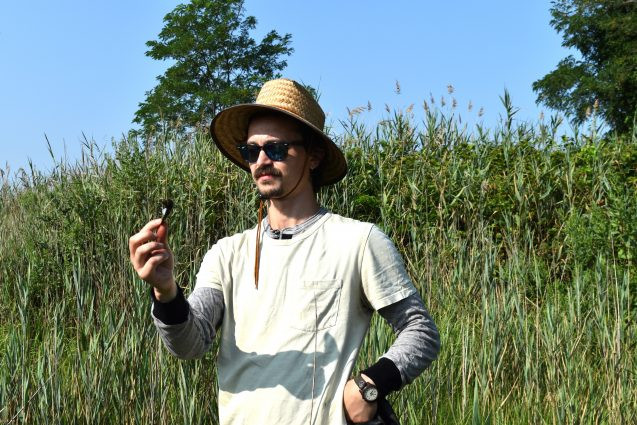She's on a Mission to Plumb the Secrets of New York's Disappearing Wetlands
Botanist and climate scientist Dorothy Peteet has been in the business digging deep into bogs, marshes and fens for more than 40 years, revealing natural and human histories going back thousands of years, and their role in changing climate. A final frontier: the obscure remains of New York City’s once widespread coastal wetlands.
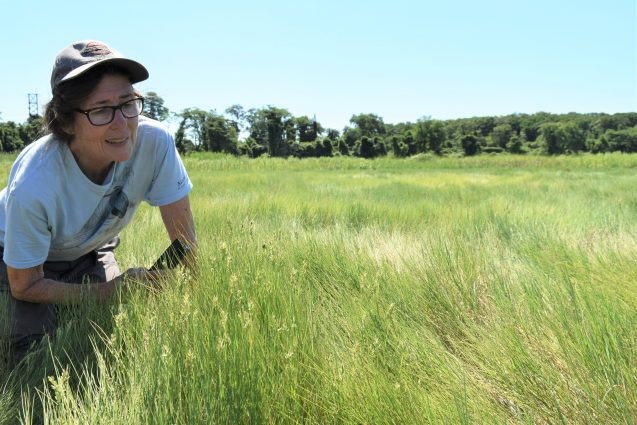
It was 10 o’clock on an August morning, and the sun was already broiling. Wearing a flannel shirt and thick rubber gloves, Dorothy Peteet veered off a woodland trail in the Bronx’s Pelham Bay Park into a thick melange of brambles, fallen logs and poison ivy. About 100 feet in, she arrived at the border of a wetland ringed by a 10-foot-high wall of Phragmites—densely packed, razor-edged giant grasses. Carefully, Peteet pushed in, step by step parting the thick stalks to clear a narrow path, on the lookout for ankle-twisting watery holes. Behind her trailed three teen students.
After a few minutes, the group emerged in view of some of the most, and least, wild land in New York City. Not far off: the giant towers of Co-op City, the largest housing cooperative in the world; the traffic-choked Hutchinson River Parkway; and an embankment topped by a rumbling Amtrak train. Directly in front of them: Goose Creek Marsh at low tide, part of a 195-acre expanse of coastal wetland. Carpeted by tousle-headed wild cordgrass blowing in a slight sea breeze, it was cut by meandering creeks and little ponds, and alive with birds.
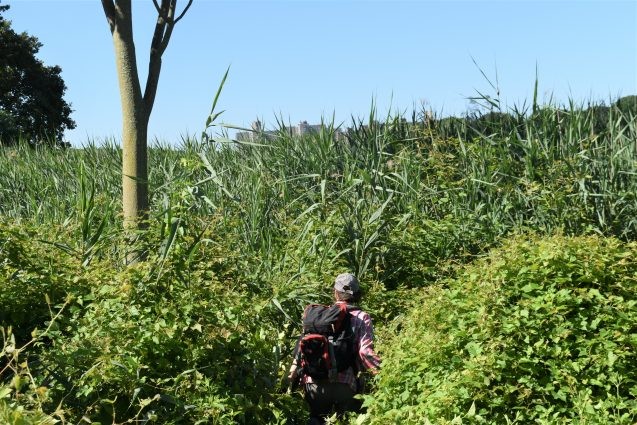
Peteet, a botanist and climate scientist, had come to measure the depth of the sediments underlying the marsh, a rare remnant of the vast wetlands that once comprised much of what is now New York City. Most have been devoured by centuries of landfilling and development, and the rest are now being slowly drowned by sea-level rise.
Wetlands are important for many reasons. Foot for foot, their thick sediments store 50 times more carbon than equivalent areas of most forests. This is true not just of tidal marshes, but inland swamps, bogs and peatlands. “Most of the carbon in a marsh is below the roots, preserved in peat,” said Peteet. “If you want to lock up carbon, instead of planting trees, we should be protecting these marshes.”
Coastal marshes also protect nearby communities from storm surge and high tides, and soak up the excess nitrogen from fertilizers and sewage coming downstream in rivers that otherwise would pollute the ocean. And, along with inland wetlands, they are home to countless rare plants, birds, animals and invertebrates.
By the 1980s, more than half the original wetlands in the contiguous United States were lost to development. The destruction has since slowed, but the nation is still losing some 80,000 acres each year. It is a global problem, and in the United States, coastal wetlands are the most endangered. The nonprofit Climate Central estimates that if business continues as usual, nearshore development and climate-driven sea-level rise could wipe out three quarters of all remaining U.S. coastal marshes by 2100. New York City has already lost around 90 percent.
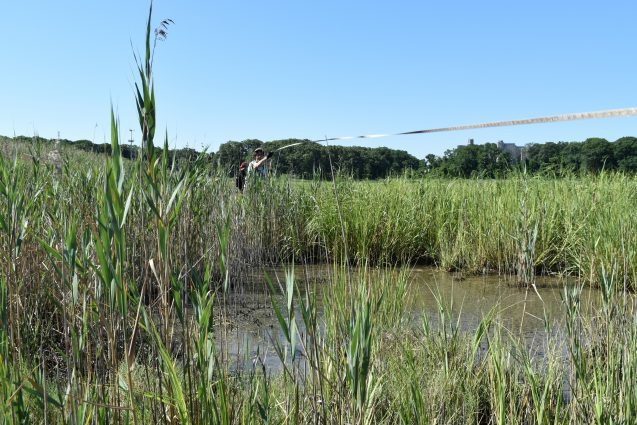
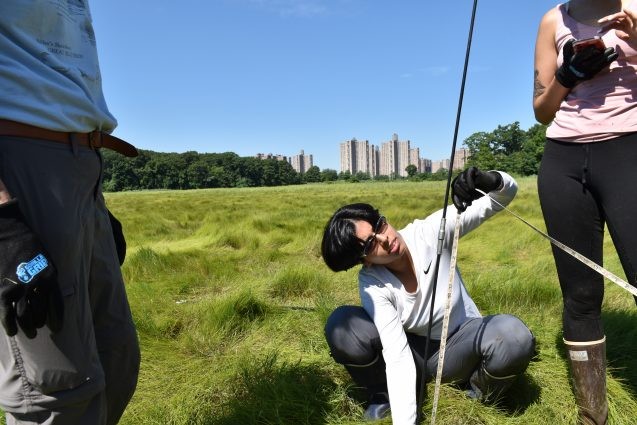
Peteet, who is based at Columbia University’s Lamont-Doherty Earth Observatory and the NASA Goddard Institute for Space Studies, has been studying wetland and lake-bottom sediments for the last 40-plus years. Starting in the soggy Alaska tundra as a student in the late 1970s, she later took samples in Siberia, Kenya and the Brazilian Amazon. She went on to work on projects with two of the top climatologists of the 20th and 21st centuries: Lamont’s Wallace Broecker, credited with coining the term “global warming,” and Goddard Institute director James Hansen, who in 1988 famously warned Congress that greenhouse gases were warming the planet, and action was needed.
“Neither land nor water, maybe both, a marsh is a balancing act, a collaboration between changing elements, uncertain by its very nature,” wrote Peteet and her coauthor Daniel Wolff last year in an extended essay titled “Why a Marsh?” “It’s important to figure out how a marsh works, how it survives, why.”
Wetland sediments form as material flows into chronically flooded low-lying areas via air or water, and the remains of dead plants that have grown there build up over centuries and millennia. Coastal marshes, fed largely with mud from rivers, creeks and daily tides, can grow especially fast; in some, the first meter or so of sediment represents just the last 400 years. The deepest sediments in the New York area that Peteet has probed are in the Hudson River estuary village of Piermont, at 17 meters, or about 56 feet.
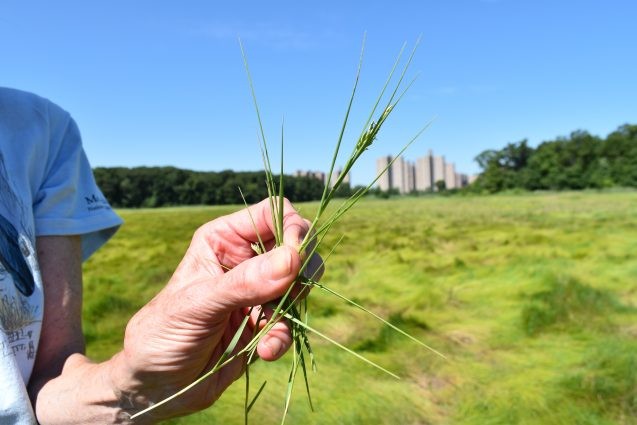
Sediments are useful for climate science and other fields because they entomb all sorts of interesting things that signal what past environments were like, and present a context for present and potential future changes. Their contents include pollen, microscopic fossils of shelled creatures, charcoal from wildfires, seeds, differing levels of certain chemical isotopes, and occasional macrofossils of animals or plants.
“What’s great about pollen is you can compare it with pollen in ocean cores that go much farther back,” said Peteet. “And seeds! You can get them down to the species. These are tiny details that matter for putting together the pieces of big puzzles.”
To get at shallow sediments of a few feet, Peteet and her colleagues drive a hollow corer into the muck and yank up the material that fills it. For deeper samples, they have to drill an open-ended pipe downward, screwing in new sections of pipe on top as the bottom section descends, much like drilling for oil. In either case, it requires plenty of muscle and then endless hours in the lab isolating samples, doing chemical tests and meticulously counting pollen grains or other tiny specimens under a microscope.
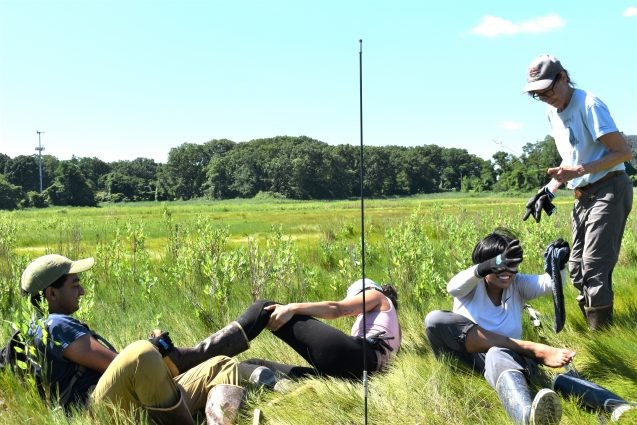
Some of Peteet’s earlier New York–area work focused on the end of the last ice age. Some geologists thought it started more than 20,000 years ago. But by plumbing inland sediments to gravel or bedrock, she and colleagues found nothing older than 15,000 or 16,000 years, suggesting that conclusive retreat was more recent. She later documented at least three major droughts over the past 6,000 years unlike anything in historical times, overturning the assumption that the Northeast is not susceptible to such events.
Later studies traced the effects of European settlement starting in the 1600s, showing massive shifts in vegetation as settlers cut down forests for agriculture. Then later, deposits of heavy metals as industrialization took hold, pollution from municipal trash incinerators whose use peaked in the 1930s, and radioactivity from nuclear-bomb tests in the 1950s and 1960s.
More recently, Peteet has increased her focus on the present. The trip to Pelham Bay was part of a NASA project to draw a national map of which coastal marshes should be prioritized for preservation, based in part on the amounts of sediment they harbor, and thus how much carbon they store.
Emerging into Goose Creek Marsh, Peteet deployed her students to take depth measurements. This involved driving a thin, flexible pole about 40 inches long, much like a portable tent pole, into the muck. If it didn’t meet resistance, the students screwed an identical pole into the top of the first one, and kept pushing down, until they hit solid bottom, signaling the gravel and boulders laid down at the end of the last ice age. They performed probes every 10 meters, or about 33 feet, over several transects.

The Pelham Bay area was once a watery archipelago of islands and peninsular beaches spread among open water and tidal wetlands. When settlers arrived, they began filling in the wetlands on a small scale. This process ballooned in the early 20th century, with much of the area filled in for housing, highways, an airport, and the now-defunct Freedomland U.S.A. amusement park. In the 1930s, large tracts were declared public park land, but a lot was then buried to create beaches, golf courses and parking areas. Garbage was a major ingredient of the landfill; the last dump closed only in 1975. Most of the 2,800-acre park is now solid land, the marshes reduced to an afterthought.
At high tide, the Goose Creek Marsh is under two or three feet of water. But it being low tide, we were able to navigate on the spongy ground in knee-high boots without getting wet—until almost everyone sooner or later plunged into a well-camouflaged soft spot, and their boots got topped.
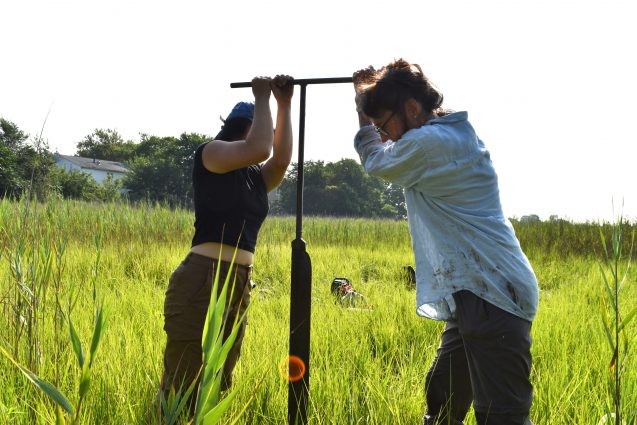
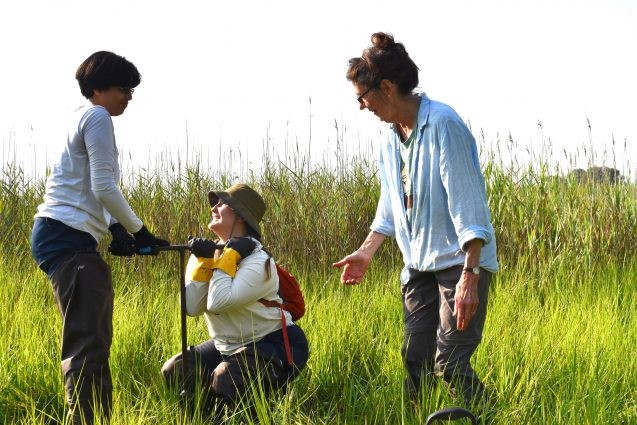
Peteet had the students pause to observe whenever wildlife showed up. Here was a marsh hawk circling, and handfuls of swallows flittering above the surface. A ways off, she picked out a bluish heron wading upright, then a pure-white egret. She discussed the fine points of native cordgrass, Spartina alterniflora, covering most of the surface. This marsh and others nearby shelter lots of things we weren’t seeing, she said: some 300 species of resident and migratory birds and 90 types of fish, along with crabs, mussels and small mammals.
The once widespread Spartina lives in a delicate dance with the tides. It needs saltwater to grow—but needs that water to go away twice a day so as not to drown. Around New York, sea level is going up each year about 4.5 millimeters, or something less than a quarter inch. Absent human development, silt, sand and clay flowing into the marsh from inland normally would help counteract this. But now, Peteet has shown, only about 2 millimeters per year are entering, because most of the land and waterways that once provided this material have been paved or built over.
So, the marsh is in trouble; as the sea encroaches, plants at the outer edges are being drowned. As plants die off, these outer segments turn into barren mudflats. There, without plants to anchor the material, tides and storms wash ancient sediments into the sea, where microbes break down much of it. “Then most of it ends up back in the atmosphere,” said Peteet.
She estimates that a third to a half of Pelham Bay’s remaining marshland has been lost to the sea in the last 50 years, and she thinks the process is accelerating. She produced a map of the marsh, with the healthy inner sections filled in with blue, and the washed-away outer sections in red. “Just in the past year, I can see it disappearing month by month,” she said. “I can’t believe how fast this is happening.”
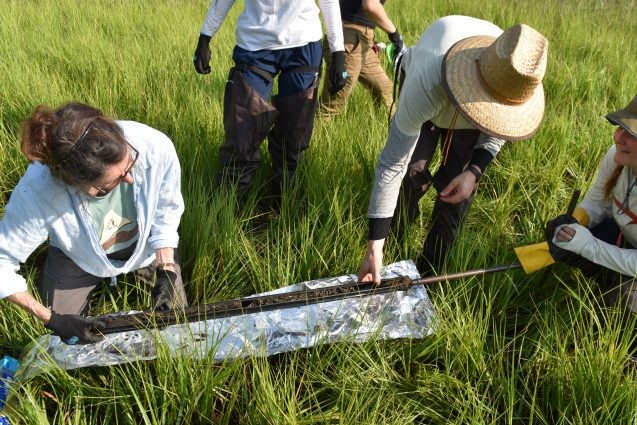
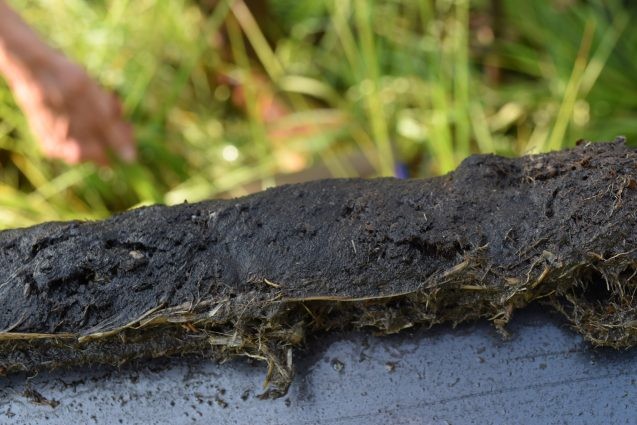
The government and private groups have joined to fight back against sea-level rise in some places. In parts of Jamaica Bay, a much larger estuary spanning the boroughs of Brooklyn and Queens, vessels are spraying sediments dredged from underwater back into the marshes to raise their surfaces, and volunteers are replanting native Spartina in areas where it had disappeared. However, these projects cover only modest areas, and they are very expensive.
At the end of the day in Goose Creek, the team added up the results of their probes. Most of the marsh sediments were only a modest 2 or 2.5 meters deep. Peteet was disappointed. “I thought this one would be deeper. If you were going to choose which marshes to save, I guess this one would not be at the top of the list,” she said.
On another August day, Peteet assembled a larger team composed mostly of grad students to take cores from a marshland in the city’s Idlewild Park Preserve, just off Jamaica Bay. Much of the marsh was bordered by sports fields and houses perched on a high embankment of artificial fill. Along one block-long section, Illegally dumped appliances, broken furniture, construction debris and plain old garbage spilling from black plastic bags was eating into the marsh. To the southwest lay its most prominent next-door neighbor: JFK Airport, whose construction starting in the 1940s consumed vast swaths of wetland, leaving this modest expanse of Spartina a lonely survivor.
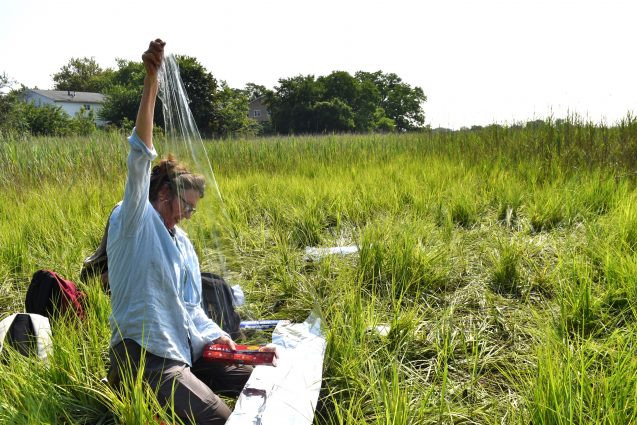
The team hauled its equipment down an embankment, including a six-foot-long steel coring contraption made in Russia. After assembling the corer’s components, everyone took turns plunging it into the spongy surface. When it reached its maximum depth, they turned it 180 degrees to trap a sample behind a vertical cutter running the corer’s length. When it came up, so did the smell of hydrogen sulfide, produced by anaerobic bacteria in the sediments.
Every two minutes on the dot, a giant jet roared overhead, startlingly close, low and slow, on its way to land.
“I love coring,” said Clara Chang, one of Peteet’s grad students. “You open it up, and it’s like a present. You don’t know what you’ll get.” But to the untrained eye, each core was a largely identical tangle of muddy blackish matter and plant roots. Peteet and her assistants wrapped each one carefully in aluminum foil and plastic wrap. “This might be 1,200 years old at the bottom,” said Peteet. “We’ll figure it out when we get it back to the lab.”
She already had some data on this marsh. Digging here has indicated that 100 years ago, it hosted a different species of Spartina, indicating that it was at a higher level in relation to the tides. Now, it was what Peteet called “low marsh”—the next stage before mudflats, and oblivion.
But for now, it was still a marsh. Out in the grass, a student picked up a big, bright green praying mantis. In a tiny pond, tiny fish were darting around. Nearby in a spot of mud was a crisp, new coyote paw print, apparently laid down since the last high tide, and destined to disappear with the next one.
